The original Flywrench was released nearly a decade ago and became something of a cult classic within the Game Maker community, but we’ll be looking at the far sleeker, much longer, and just all-around better 2015 version. As a brutally difficult action game which isn’t quite a platformer, Flywrench tasks you with flapping and spinning your way through color-coded gates at lightning speeds in well over 150 levels. It’s unforgiving, it’s refreshingly original, and it’s a whole lot of fun.
The gameplay in Flywrench is simplistic, though actually mastering it is another matter entirely. You control a white triangle and the objective of every level is to touch a spinning white square at the end. Gravity is a constant concern and you’ll die if you touch any of the walls. As far as abilities go, you mainly move by pressing a button to flap, making the rectangle bend its two sides into an upside-down V-shape to give it a bit of a boost. You rapidly gain momentum if you flap multiple times in a row and this can be useful if you need to move quickly, but it also makes it far harder to avoid hazards so learning to glide through the air while occasionally flapping to reorient yourself or to slow your downward momentum is rather important. In addition to regular flapping, you can perform a much stronger flap by holding up at the same time while pressing down while flapping will greatly decrease (though not necessarily stop) your upward momentum or slightly boost your falling speed. Other than flapping, you can also press another button to spin. You’ll keep spinning as long as you hold down the button and you don’t have any control over your movement while spinning so you need to plan out your momentum and angle in advance, but you can also bounce off of walls while in this state. Though these are the only abilities you have at your disposal, the color system is where Flywrench gets interesting.
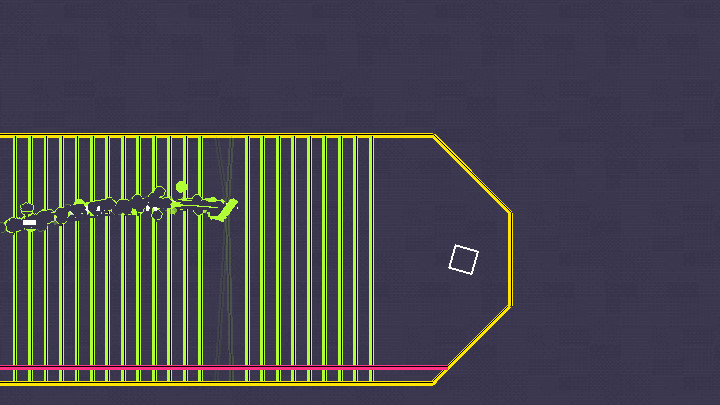
Color matching is an essential component to the gameplay here. Your rectangle is white in its default state, but it turns while it’s spinning and it folds itself into a smaller, red vertical rectangle while the flap button is held down. These color changes are important because just about every level involves passing through hazards by matching their color. For example, you can safely fall through white barriers by doing nothing at all or you can rapidly flap to gain momentum and hold the button down on the final flap to rocket upward through a set of red barriers. Of course, the real challenge begins when you have to rapidly change between your three colors to pass through sets of hazards and when you have to use colors in difficult ways, such as upward white barriers which require you to build up enough momentum from flapping to punch through them while neutral.
Every hazard in the game can be linked to one of your three colors, but there are also three other colors to be wary of. Yellow is a color reserved exclusively for walls and you can bounce off of it while you’re green from spinning; Helmet Mode is the easy difficulty setting in Flywrench and it grants you a yellow square which allows you to bounce off of yellow walls regardless of your color. Pink is the most dangerous color because it will kill you on contact regardless of your current color and both hazards and walls can be pink. Last of all, blue is largely identical to pink, but anything blue can be deactivated for a few seconds after touching a switch, so this color is primarily used to add in some time pressure in the form of gates which players must rush through after deactivating them.
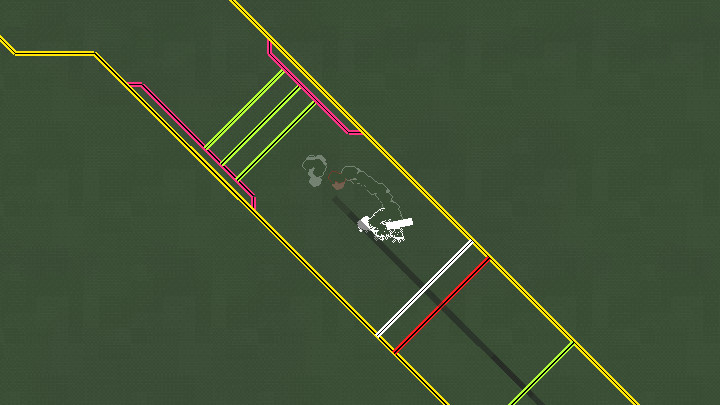
If you are colorblind or simply don’t like the default color choices, the Options menu contains quite a few different themes to choose from and you can even make your own, though this latter option is unintuitive as it requires the activation of a developer tool by pressing Ctrl+F1 (I’d recommend looking at the Steam guide by MidorinoTaisou on the subject if you want to make your own themes). Whatever your theme preference may be, the color system in Flywrench adds in a crucial additional layer of depth, transforming the gameplay from a simple matter of avoiding hazards into a far more demanding experience where you must constantly take your momentum into account and where you must precisely time your color changes while taking both the advantages and disadvantages tied to each color’s form into account.
Though they are used effectively, there aren’t actually all that many different types of hazards. The most common type of hazard is the barrier, which is really just a simple line serving as a wall tied to a color. Some barriers move back and forth along basic paths in later levels and they can push you a bit if you don’t have enough momentum even while matching their color and these moving barriers can become particularly dangerous when multiple barriers of different colors are moving along the same path; it’s impossible to defend yourself from two colors at the same time so touching different barriers while they’re overlapping is a death sentence. Meanwhile, pinwheels consist of four lines tied to a stationary central body. Pinwheels come in various sizes and can rotate either clockwise or counterclockwise. Like blue gates, pink pinwheels are often used to add in some serious time pressure and it’s fairly in later levels to be forced into moving with a pink pinwheel going in one direction while flying through the blades of a red, white, or green overlapping pinwheel spinning in the opposite direction. There are also small stationary turrets which periodically shoot projectiles at you. Turrets come in every color except yellow and their projectiles match their color, but turrets in general just aren’t used that often, most likely because it’s difficult to combine them with the other hazards while maintaining a fair level of difficulty.
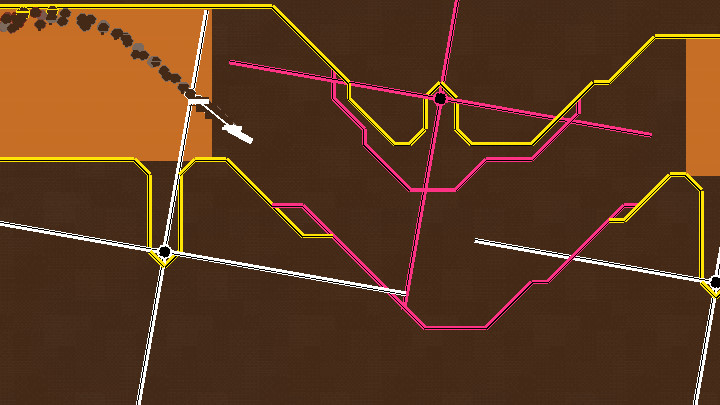
The final type of hazard is super gravity and it is the most dangerous of all. Any part of a level with an orange background is affected by super gravity which will pull you downward with a significant amount of force. Though it can’t kill you directly, long stretches of super gravity can be difficult to navigate through, especially if barriers or other hazards are within them, and you also need to be wary of accidentally flinging yourself into a wall once you leave a super gravity zone. Overall, these hazards are all rather basic, but they can provide some incredibly difficult challenges when used alongside each other.
Like everything else in Flywrench, progression through the main campaign is simplistic, but it’s handled well. There’s no story to speak of beyond a few cryptic lines at the start of each region so gameplay is what really matters here. The game takes place within our solar system with each planet serving as a region filled with somewhere around 15-20 levels, give or take a few. You can only access Pluto at first and completing enough levels will unlock access to the next planet as you make your way ever closer to the Sun. Most of the time you can choose between three levels at a time on each planet so you can easily skip a level if it’s proving to be too difficult and the unlock requirements on the planets are generous enough that you can gain access to every planet from Pluto to Mercury with quite a few skipped levels along the way, though the Sun, which serves as the final area of the game, requires you to beat every previous level to access it. The planets themselves are balanced well with the first one or two levels of a planet serving as introductions to a new mechanic while most of the remaining levels on that planet utilize that mechanic in various ways. Even though the later levels can be incredibly difficult, the learning curve is a rather generous one; the only hazards on Pluto are red and white gates while green and then pink barriers are introduced on Neptune and Uranus respectively.
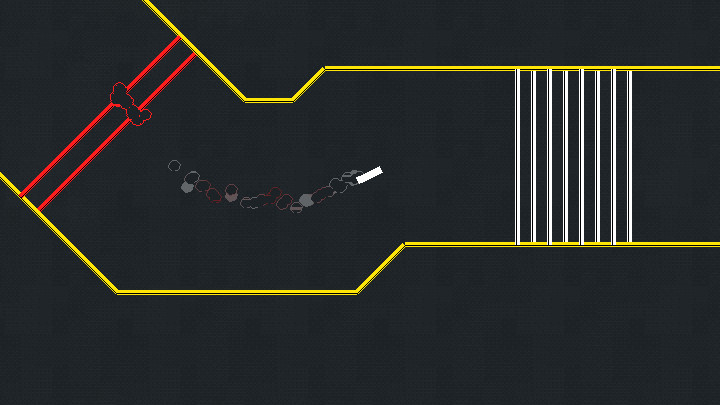
The only time Flywrench drops the ball when it comes to difficulty balance occurs when you arrive on Mercury as there is a significant spike up in difficulty between the end of Venus and the start of Mercury. Flywrench is the type of game where you’ll build up plenty of muscle memory from rapidly dying and respawning within a single level, but even with this in mind the spike between Venus and Mercury is noticeable enough that I wish there was a bit more of a difficulty buffer between the two, especially since the Sun’s complete lack of leeway when it comes to level completion means there is no reason to ever skip levels once you arrive at Mercury. That said, this jump in difficulty is far from a game-breaking issue and if anything the fact that it stands out simply highlights how incredibly well the rest of the game is balanced.
Beyond the campaign, the two biggest things Flywrench has to offer is a time trial mode and player-created levels. Any player-created level as well as any level which you have completed in the campaign can be played within the time trial mode. Levels are grouped based on the planets which they are found on and you can choose to preview any level, which automatically pans the camera in a straight line across the level from the start to the exit. Each level can be played individually, but online leaderboards are only available for entire planets so the focus here is on becoming good enough not just to complete a single level quickly, but to become capable of flying through entire sets.
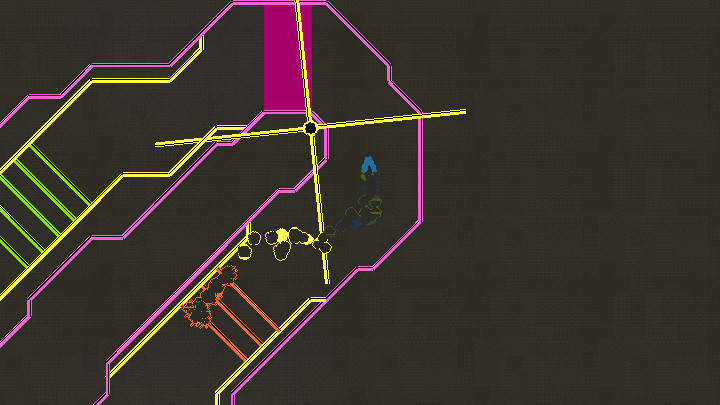
As far as creation is concerned, the level editor was easy to work with simply by using a mouse. You start by naming your own planet and from there you add individual levels to it which you can freely rearrange. By default there is a visible grid and tooltips whenever you place your cursor over an item and these are generally rather useful, though it took me a while to figure out that horizontal movement altered the line lengths for pinwheels while vertical movement determined their movement direction. Placing any sort of line is just a matter of clicking and dragging and you just need to click on colors to change between them. Since levels are tied to planets, you can get entire sets of levels to test out from the Steam Workshop instead of being forced to pick them out individually. Between the online leaderboards and the ease with which you can both make and play new levels, there is plenty of content beyond the campaign.
Flywrench is a game which is every bit as strange as its title and it has an incredibly polished execution to match its unique concept. With a challenging yet almost perfectly balanced campaign, an intuitive level editor which has already resulted in the creation of hundreds of player-created levels to check out, and simplistic gameplay with enough hidden depth that it can take hours to even begin to master, Flywrench excels across the board.